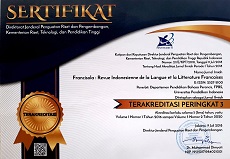Extension sémantique de lexie chez des apprenants chinois plurilingues
Abstract
RÉSUMÉ. L’extension sémantique, un genre d’erreur interlinguale dans la production en français (L3) des apprenants chinois dont L2 est l’anglais, présenterait-elle des influences translinguistiques des deux langues : chinois (langue maternelle) et anglais ? Telle est la question de cette recherche réalisée par le biais d’une enquête menée auprès de 137 étudiants de français dans quatre universités chinoises, afin de découvrir le mécanisme de mental processing des apprenants plurilingues. Avec les analyses quantitatives (Test-t) et qualitatives des productions écrites et en s’appuyant sur des théories de transfert (Swan, 1997 ; Jiang, 2000 ; Wei, 2009) et la théorie du prototype, on découvre que l’interférence des lemmes plurilingues (chinois-français, anglais-français, chinois-anglais-français) remonte à des extensions sémantiques : Les catégories sémantiques des lemmes n’étant pas les mêmes, les apprenants auraient tendance à construire certains lemmes de L3 (le français dans ce cas) en se balançant entre ceux de L1 et de L2. Ainsi, il faut considérer davantage les influences des langues non-cibles, notamment l’interférence de L2 dans l’enseignement/apprentissage de L3.
Mots-clés : Extension sémantique, habileté, influence translinguistique, lemme, source de transfert
ABSTRACT. Semantic extension, a typical interlingual error in French-language production (L3) of Chinese students (their L2 is English), does it present the cross-linguistic influence of two languages: Chinese (mother tongue) and English? This is the research question, realized by a survey conducted among 137 students of French in four Chinese universities, in order to discover multilingual learners’ mental processing mechanism. With quantitative (T test) and qualitative analysis of written productions, using the transfer theories (Swan, 1997; Jiang, 2000; Wei, 2009) and prototype theory, the research discovers that the interference of multilingual lemmas (Chinese-French, English-French, Chinese-English-French) accounts for semantic extensions: the learners tend to construct some lemmas of L3 (French in the case) by swaying between lemmas of L1 and L2. Thus, it needs to consider further the influences from non-target languages, particularly the interference of L2 in teaching/learning of L3.
Keywords: cross-linguistic influence, lemma, semantic extension, skill, source of transfer
Full Text:
PDFReferences
Biskup, D. (1992). L1 influence on learners’ renderings of English collocations : A Polish/German empirical study. In Pierre, J., Arnaud, L. et Béjoint, H. (eds.), Vocabulary and Applied Linguistics, 85-93. London : Macmillan.
Bouvy, C. (2000). Towards the construction of a theory of cross-linguistic transfer. In Cenoz, J. et Jessner. U. (eds.), English in Europe : The Acquisition of a Third Language, 143-156. Clevedon : Multilingual Matters.
Fontes, A. B. A. D. L. et Schwartz, A. I. (2015). Bilingual access of homonym meanings : Individual differences in bilingual access of homonym meaning. Bilingualism : Language and Cognition, 18(4), 639-656.
Hasselgren, A. (1994). Lexical teddy bears and advanced learners : A study into the ways of Norwegian students cope with English vocabulary. International Journal of Applied Linguistics, 4(2), 237-258.
Jarvis, S. (1998). Conceptual transfer in interlingual lexicon. Bloomington : Indiana University Linguistics Club Publications.
Jiang, N. (2000). Lexical representation and development in a second language. Applied Linguistics, 21(1), 47-77.
Kempen, G. et Huijbers, P. (1983). The lexicalization process in sentence production and naming : Indirect election of word. Cognition, 14(2), 185-209.
Levelt, W. (1989). Speaking: From Intention to Articulation. Cambridge, MA : The MIT Press.
Ringbom, H. (1978). The influence of the mother tongue on the translation of lexical items. Interlanguage Studies Bulletin, Utrecht, 3 (1), 80-101.
Ringbom, H. (1987). The Role of the First Language in Foreign Language Learning. Clevedon. UK: Multilingual Matters.
Ringbom, H. (2001). Lexical transfer in L3 production. In Cenoz, J., Hufeisen, B. et Jessner, U. (eds.), Cross-linguistic influence in third language acquisition : psycholinguistic perspectives, 59-68. Clevedon : Multilingual Matters.
Ringbom, H. (2007). Cross-linguistic similarity in foreign language learning. Clevedon : Multilingual Matters.
Swan, M. (1997). The influence of the mother tongue on second language vocabulary acquisition and use. In Schmitt, N. et McCarthy, M. (eds.), Vocabulary, description, acquisition and pedagogy, 156-180. Cambridge : Cambridge University Press.
Wang, Y. (2014). Researches on Philosophy of Language : Meditation on China’s Post-Philosophy of Language. Beijing, China : Peking University Press.
Wei, L. (2009). Intrasentential codeswitching : bilingual lemmas in contact. Concentric : Studies in Linguistics, 35(2), 307-344.
DOI: https://doi.org/10.17509/francisola.v4i1.20338
Refbacks
- There are currently no refbacks.
Copyright (c) 2019 FRANCISOLA

This work is licensed under a Creative Commons Attribution-ShareAlike 4.0 International License.
View My Stats











